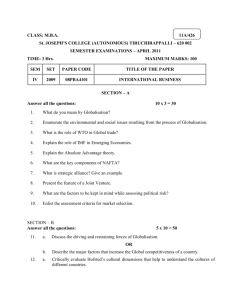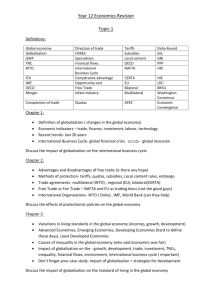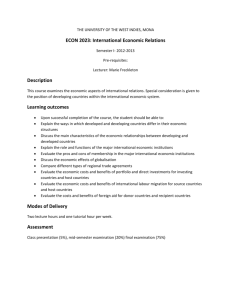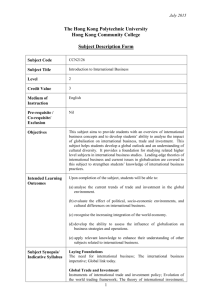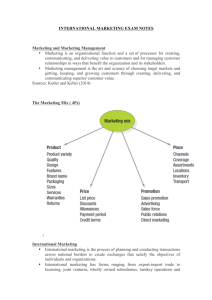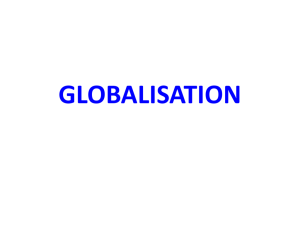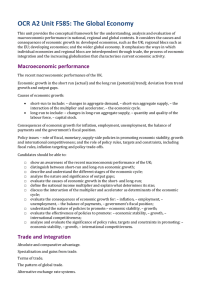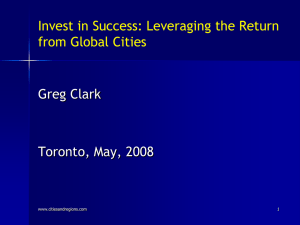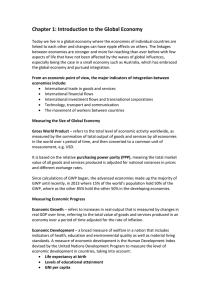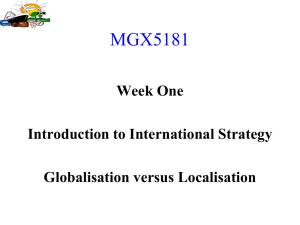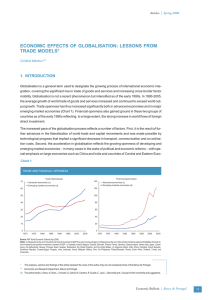National Teacher Conference
advertisement
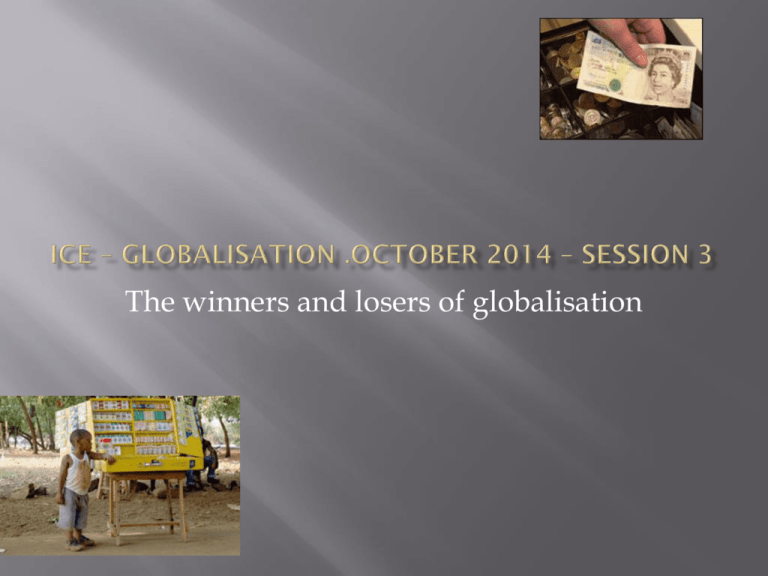
The winners and losers of globalisation Economic integration and trade liberalisation have produced an unstoppable movement toward economic globalisation. Most economists applaud the trend, pointing to the modernisation and growing wealth that have resulted. But some countries have been left on the sidelines or have even been harmed by globalisation. What have been the positive and negative effects of the trend? And more importantly, since globalisation seems certain to continue, what can be done to make its benefits as widespread as possible? One other issue to consider Has soft power become as important as its hard power brother? •New markets partly driven by privatisation ( FDI’s, why and where?), deregulation, •New Actors – MNC’s – some larger than small EU states •New Communications and Global Networks - BBC World, CNC and - Al Jazeera English •New and faster/wider access to knowledge •New rules – human rights, the environment and growing public awareness Developed countries have been especially affected by new information and communication technologies that boost efficiency but make some whitecollar workers redundant Some food for thought? - 2/3 of international trade is accounted for by just 500 corporations. 40% of the trade they control is between different parts of the same MNC. Of the world's 100 largest economies, 50 are MNCs. For Capital flows will be determined by comparative advantage of nations There will be a wide distribution of technology and 'technology' and 'skills' transfer Wider choice for consumers Dismantling of any trade barriers An increase in the level of world trade Increased access to economies of scale making products cheaper and more efficient to produce Trade determined fully by comparative advantage Increased worldwide economic growth More efficient global markets Against Investment flows will often ignore the less developed countries (LDC's) Labour costs are driven down and living standards may also be driven down Increased monopoly power for multinational corporations Increased urbanisation in many countries International capital is mobile, but labour is not Conditions of employment deteriorate and governments put under pressure by multinational corporations Less democratic control of economic forces as power moves to multinational corporations Financial instability Unsustainable development around the world Growth of consumerism which may not be appropriate to every country Productive Capacity - these economies who could attract capital flows have been able to invest in the capacity to process and produce low level products. Many have now moved up market. They have added value effectively and moved into markets previously dominated by producers in developed economies People with assets – those with capital to invest, skills to sell and the self confidence to feel at ease in a global markets internationally transferable skills – 10 years time the largest number of English speakers will live in China Profits – these could be moved across borders easily, quickly and cheaply – so allowing them to be used to start-up new business locations, or develop existing enterprises - the privatisation boom that followed collapse of communism in the Soviet Union and its eastern satellites Adaptive firms and workers – could react to change, possibly drive/predict it and so be ahead of the norm and charge accordingly – short lead times Techno-specialist – needed to support the changes driving globalisation and the growth of MNC’s Those not dependent on public services – could adapt to change more quickly, not weave through red –tape and so react and lead and move into profitable area s – again attractive lead times Large companies – had the resources to adapt, take advantages of innovation by smaller rivals and consolidate presence in markets Men – perhaps less obvious but in many of the low income countries men have moved into the ‘new’ industries leaving women to remain at home, farming and bringing up families International markets – again react, lead times, depth of core competence and competitive advantage – they had the resources the think global and adapt to changes Global culture – the importance of global presence in art, literature, politics, communications – these all drive tastes and product acceptance East, S.E. Asia - the economies with an abundance of labour, less stringent legal systems, political certainty, local mass markets, rural urban drift Small companies – lack resources, bargaining power to compete in global markets Women – less educated, less flexible, less likely to move to urban areas, cultural norms – left to work in fields etc Local communities – lost some of their best people to cities, lost revenues, services and ability to attract inward investment Local culture – fighting against the power of capital driving mass culture Inability to process resources – depressed income streams, lower tax receipts, less central and local government expenditure, poorer support infrastructure Land locked economies – though Switzerland is OK, it’s in developing world where the lack of infrastructure in neighbouring economies is very important An analysis of globalisation's winners and losers suggests a number of policies that can be adopted to diminish the liabilities while encouraging the benefits of economic integration: Create transnational institutions to develop and enforce global antimonopoly, anti-cartel and anti-restrictive practices and legislation. What of a Tobin Tax, favoured by Gordon Brown – or the role of IMF in financial sector regulation across global transactions – have we really thought through the consequences of globalisation? Crime, soft power – Bin Laden – this and Palestine In the developed countries, implement training and education programs, ( capacity building) provide income support for low-wage workers, and adopt tax policies that create jobs. Let’s return to the main determinants of globalisation and note how these have impacted on the poorest – what Paul Collier calls the ‘ bottom billion’. Reduce uncertainty by signing up to international conventions on trade and investment. Encourage pro-poor business development services (especially better flow of information on market requirements) via partially self-supporting agencies. – the bottom of the pyramid ( Prahalad) – excellent read – soap in India and girl’s products in Ghana and Rwanda. Plan safety nets to ensure minimum living standards for globalisation’s losers. – Who is going to pay? Invest in construction and maintenance of infrastructure such as ports and roads. Allow marketing bodies to be quasi-autonomous with an element of selffinancing. Also, encourage self auditing by developing countries NEPAD Let the market identify particular future growth sectors. The record of states which have tried to do so is poor. But what of market failures? Encourage women to take financial risks, encourage micro finance, female only banks, family planning, education at night, distance learning etc Resource dependency – 29% of those in the bottom billion live in resource dominated economies Increase developing country market access particularly for agricultural products. CAP but also inter-regional trade (small at present – trade blocks/single markets) A 40 percent cut in agricultural subsidies would deliver estimated benefits of $70 billion, which would help developing countries to make large gains relative to GDP. Ensure developing countries receive an appropriate share of income from taxing multinationals. Transfer pricing and tax haven registration Name and shame companies involved in environmental asset stripping, financing conflict, tax evasion or other morally reprehensible practices. Support voluntary labour, environment and fair trade schemes. Assist countries of the south to access bond markets. Or encourage them to save/invest themselves – may be end direct aid – over a five year period? Remove the current uncertainty about aid flows by an agreed international system of transfers. How shall it be distributed and by who – some favour more to sovereign government to cut corruption and make system more transparency Others fear that this would increase the above – what of role of NGO’s, international institutions. Place on expanded P5, more UN offices in developing world? Improve infrastructures in neighbouring economies – especially in landlocked economies – growth spillovers Improve coastal access, improve access to internet, encourage remittances, look to reduce gap between rural and urban economy, try to attract highly focused aid, that included technical ability capacity building
